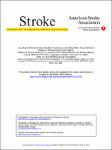Low ankle-brachial index predicts cardiovascular risk after acute ischemic stroke or transient ischemic attack
Busch, Markus
Lutz, Katrin
Röhl, Jens-Eric
Neuner, Bruno
Masuhr, Florian
Background and purpose: A low ankle-brachial blood pressure index (ABI) is an established risk marker for cardiovascular disease and mortality in the general population, but little is known about its prognostic value in individuals with acute ischemic stroke or transient ischemic attack (TIA). Methods: An inception cohort of 204 patients with acute ischemic stroke or TIA was followed up for a mean of 2.3 years. At baseline, patients underwent ABI measurement and were assessed for risk factors, cardiovascular comorbidities, and cervical or intracranial artery stenosis. The association between low ABI and the risk of the composite outcome of stroke, myocardial infarction, or death was examined by Kaplan-Meier and Cox regression analyses. Results: A low ABI was found in 63 patients (31%) and was associated with older age, current smoking, hypertension, peripheral arterial disease, and cervical or intracranial stenosis. During a total of 453.0 person-years of follow-up, 37 patients experienced outcome events (8.2% per person-year), with a higher outcome rate per person-year in patients with low ABI (12.8% vs 6.3%, P=0.03). In survival analysis adjusted for age and stroke etiology, patients with a low ABI had a 2 times higher risk of stroke, myocardial infarction, or death than those with a normal ABI (hazard ratio=2.2; 95% CI, 1.1 to 4.5). Additional adjustment for risk factors and cardiovascular comorbidities did not attenuate the association. Conclusions: A low ABI independently predicted subsequent cardiovascular risk and mortality in patients with acute stroke or TIA. ABI measurement may help to identify high-risk patients for targeted secondary stroke prevention.
Dateien zu dieser Publikation
Keine Lizenzangabe
Verwandte Publikationen
Anzeige der Publikationen mit ähnlichem Titel, Autor, Urheber und Thema.
-
2011-02-01ZeitschriftenartikelRegional differences in body fat distributions among people with comparable body mass index: a comparison across six German population-based surveys Stang, Andreas; Döring, Angela; Völzke, Henry; Moebus, Susanne; Greiser, Karin Halina; Werdan, Karl; Berger, Klaus; Ellert, Ute; Neuhauser, HanneloreIntroduction: The mortality of circulatory diseases of the German population varies considerably across regions. The comparison of the regional distributions of cardiovascular risk factors can provide clues to the reasons ...
-
2013-04-22ZeitschriftenartikelFoodborne Transmission of Bovine Spongiform Encephalopathy to Nonhuman Primates Holznagel, Edgar; Yutzy, Barbara; Schulz-Schaeffer, Walter; Kruip, Carina; Hahmann, Uwe; Bierke, Pär; Torres, Juan-Maria; Kim, Yong-Sun; Thomzig, Achim; Beekes, Michael; Hunsmann, Gerhard; Löwer, JohannesRisk for human exposure to bovine spongiform encephalopathy (BSE)–inducing agent was estimated in a nonhuman primate model. To determine attack rates, incubation times, and molecular signatures, we orally exposed 18 macaques ...
-
2009-02-19ZeitschriftenartikelEpidemiology of vertigo, migraine and vestibular migraine Lempert, Thomas; Neuhauser, HanneloreBoth migraine and vertigo are common in the general population with lifetime prevalences of about 16 % for migraine and 7 % for vertigo. Therefore, a concurrence of the two conditions can be expected in about 1.1 % of the ...

